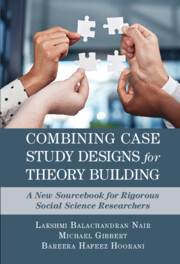 Combining Case Study Designs for Theory Building
Combining Case Study Designs for Theory Building Book contents
- Combining Case Study Designs for Theory Building
- Combining Case Study Designs for Theory Building
- Copyright page
- Contents
- Chapter 1 Introduction to Case Study Research
- Chapter 2 Building Blocks of Case Study Research
- Chapter 3 Of Talking Pigs and Black Swans
- Chapter 4 Do It Again
- Chapter 5 The Natural Experiment, a.k.a. the Single Embedded Design
- Chapter 6 Do It Again (and Again)
- Chapter 7 Sequencing Case Study Designs
- Chapter 8 More on Sequencing Case Study Designs
- Chapter 9 A Parting Note, on an Optimistic Note
- Index
- References
Chapter 1 - Introduction to Case Study Research
Published online by Cambridge University Press: 02 February 2023
- Combining Case Study Designs for Theory Building
- Combining Case Study Designs for Theory Building
- Copyright page
- Contents
- Chapter 1 Introduction to Case Study Research
- Chapter 2 Building Blocks of Case Study Research
- Chapter 3 Of Talking Pigs and Black Swans
- Chapter 4 Do It Again
- Chapter 5 The Natural Experiment, a.k.a. the Single Embedded Design
- Chapter 6 Do It Again (and Again)
- Chapter 7 Sequencing Case Study Designs
- Chapter 8 More on Sequencing Case Study Designs
- Chapter 9 A Parting Note, on an Optimistic Note
- Index
- References
Summary
This chapter introduces the readers to case study research, with the help of historical and contemporary examples. We define case study research and briefly discuss the existing case study designs. Subsequently, we explain the main purpose of this book: To take case study research to the next level by discussing the combinations of different case study designs in the same study, which we call "sequencing case study designs." Furthermore, we discuss the building blocks of case study designs, the strengths/weaknesses of archetypical designs, the conundrum surrounding the crafting/relaying of theoretical contributions, some concrete examples of designs, and the differences/similarities amongst different paradigmatic camps in case study research. We end the chapter by briefly introducing the contents of the subsequent chapters.
Keywords
- Type
- Chapter
- Information
- Combining Case Study Designs for Theory BuildingA New Sourcebook for Rigorous Social Science Researchers, pp. 1 - 9Publisher: Cambridge University PressPrint publication year: 2023
